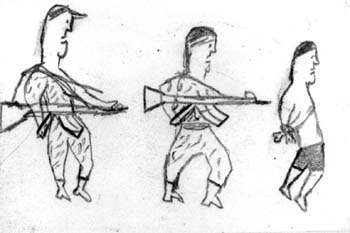 Seminar: Economics of Terrorism
Seminar: Economics of Terrorism
Lecture number: 800919
Block Seminar: January 20 (KWZ - 0.607) and January, 21 (Oec 1.163), 2017.
Kickoff Meeting: October, 31th, 13:00, Room Oec 0.169tba
Submission of Applications: November, 6th
Registration via FlexNow: November, 7th-15th.
Prep Meeting “How to write a Seminar Paper”: November, 10th, 16:00, Room VG 1.103
Submission of essays: December, 18th
Final Prep Meeting: January, 9th, 10:00, Oec 1.164
Seminar Info: info
Supervision: Johannes Schuenemann: email Viacheslav Yakubenko: email
Course material for participants is available at the course material webpage
Themes
1. The Mind of the Terrorist
Reference: Jeff Victoroff, 2005, The Mind of the Terrorist: A Review and Critique of Psychological Approaches, Journal of Conflict Resolution 49, 3-42.
2. Education, Poverty and Terrorism
Reference: Alan B. Krueger and Jitka Maleckova, Education, Poverty and Terrorism: Is there a Causal Connection? Journal of Economic Perspectives 17, 119-144.
3. Poverty, Political Freedom, and the Roots of Terrorism
References: Abadie, A. (2006). Poverty, Political Freedom, and the Roots of Terrorism. American Economic Review 96, 50-56. Bandyopadhyay, S., and Younas, J. (2011). Poverty, political freedom, and the roots of terrorism in developing countries: An empirical assessment. Economics Letters, 112(2), 171-175.
4. Does Terrorism Work?
Reference: Gould, Eric D. and Esteban F. Klor. 2010. Does Terrorism Work? Quarterly Journal of Economics, 1459-1510
5. The Costs of Terrorism
Reference: Tavares, J. (2004). The open society assesses its enemies: shocks, disasters and terrorist attacks. Journal of Monetary Economics, 51(5), 1039-1070.
6. The Long-Run Effect of 9/11
Reference: Gould, Eric D, and Esteban F Klor. 2016. The Long-Run Effect of 9/11: Terrorism, Backlash, and the Assimilation of Muslim Immigrants in the West. Economic Journal forthcoming.
7. The Economics of Counterinsurgency in Iraq
Reference: Berman, E., Shapiro, J. N., and Felter, J. H. (2011). Can hearts and minds be bought? The economics of counterinsurgency in Iraq. Journal of Political Economy, 119(4), 766-819.
8. The Effect of Political Violence on Religiosity
Reference: Zussman, A. (2014). The effect of political violence on religiosity. Journal of Economic Behavior & Organization, 104, 64-83.
9. What Drives Foreigners to Join Jihad?
References: Benmelech, Efraim, and Esteban F Klor. 2016. What Explains the Flow of Foreign Fighters to ISIS?. NBER Working Paper 22190.
Hegghammer, T. (2013). Should I Stay or Should I Go? Explaining Variation in Western Jihadists' Choice between Domestic and Foreign Fighting. American Political Science Review, 107(01), 1-15.
10. The Cycle of Violence?
Reference: Jaeger, D. A., and Paserman, M. D. (2008). The cycle of violence? An empirical analysis of fatalities in the Palestinian-Israeli conflict. American Economic Review, 98(4), 1591-1604.
11. Ethnicity, Insurgency and Civil War
Reference: Fearon, J. D. and D. D. Laitin (2003). Ethnicity, Insurgency and Civil War. American Political Science Review 97(1), 75-90.
12. Greed and Grievance in Civil War
Reference: Collier, P. and A. Hoeffler (2004). Greed and Grievance in Civil War. Oxford Economic Papers 56(4), 563-595.
13. The Geography of Civil Conflicts
Reference: Berman, N., and Couttenier, M. (2015). External shocks, internal shots: the geography of civil conflicts. Review of Economics and Statistics, 97(4), 758-776.
14. The Effect of US Military Aid on Political Conflict in Colombia
Reference: Dube, O., and Naidu, S. (2014). Bases, Bullets and Ballots: The Effect of US Military Aid on Political Conflict in Colombia (No. w20213). National Bureau of Economic Research.
15. Conflict and Foreign Aid
Reference: Nunn N, Qian N. (2014). U.S. Food Aid and Civil Conflict. American Economic Review 104(6), 1630-1666.